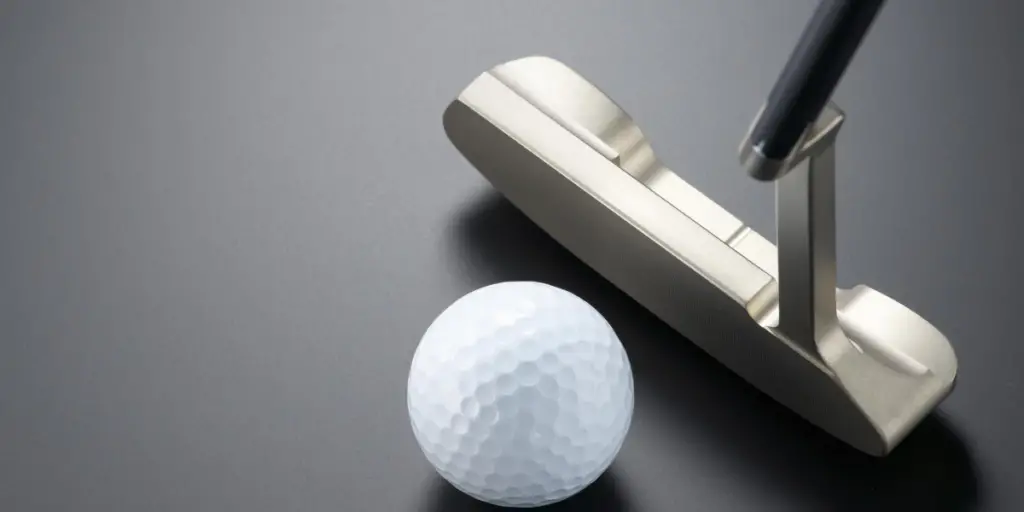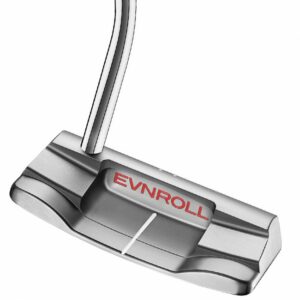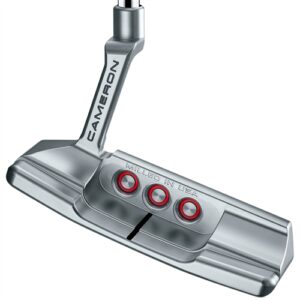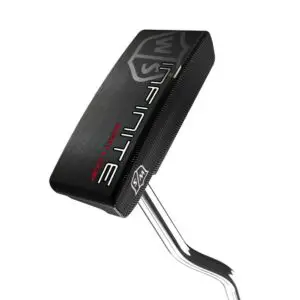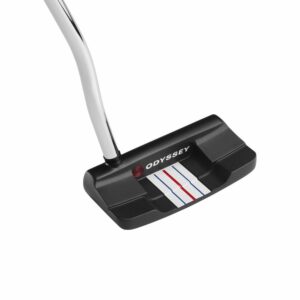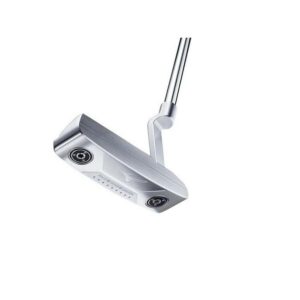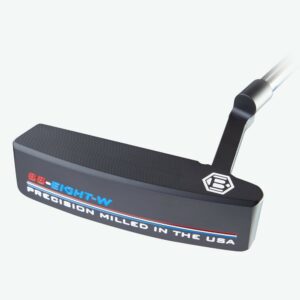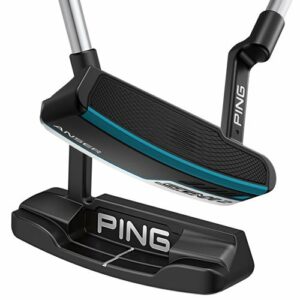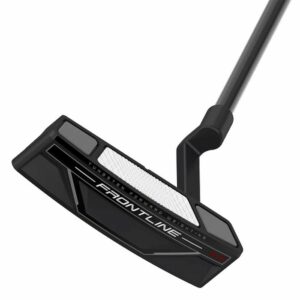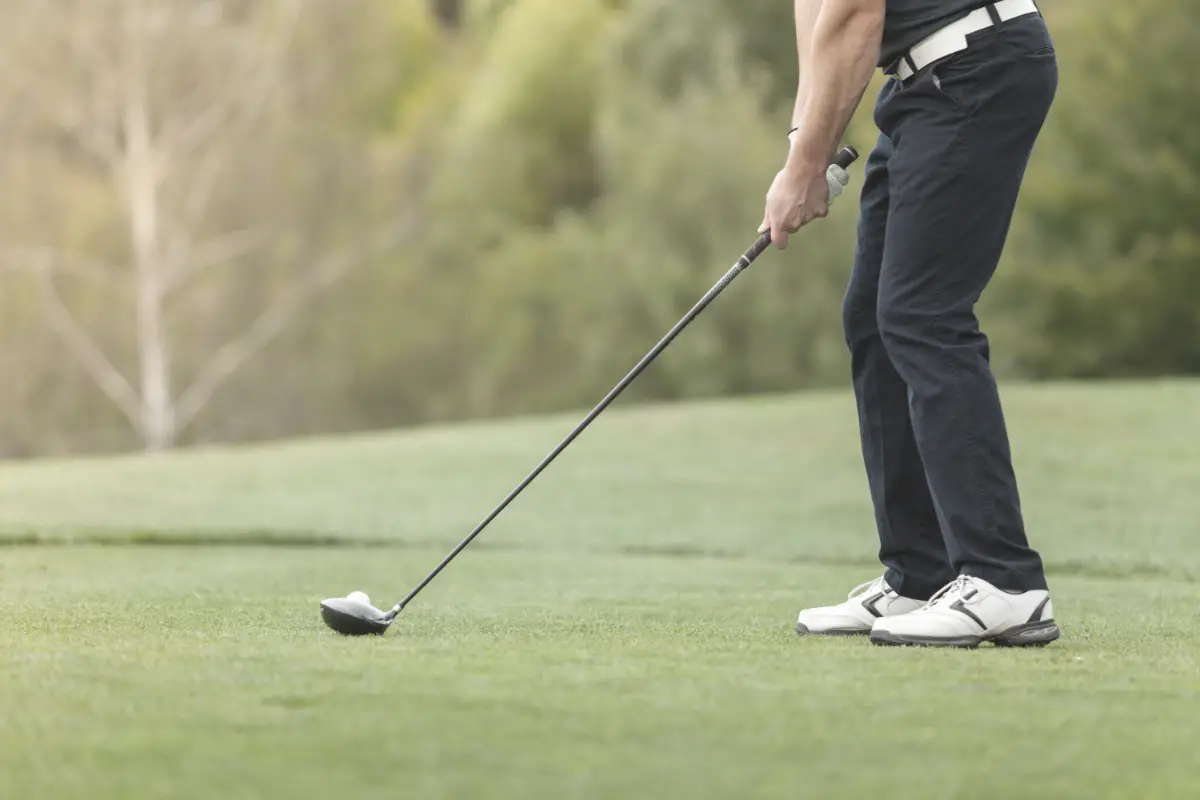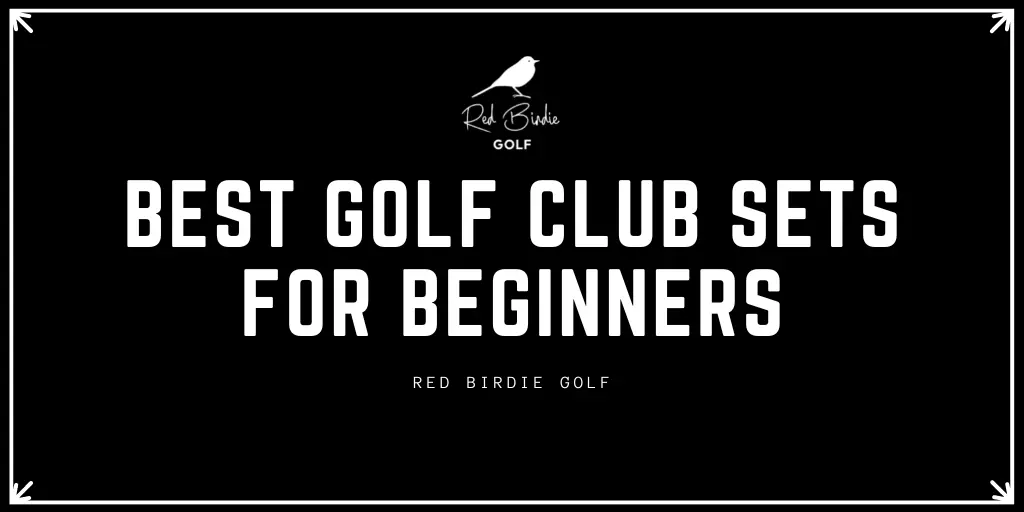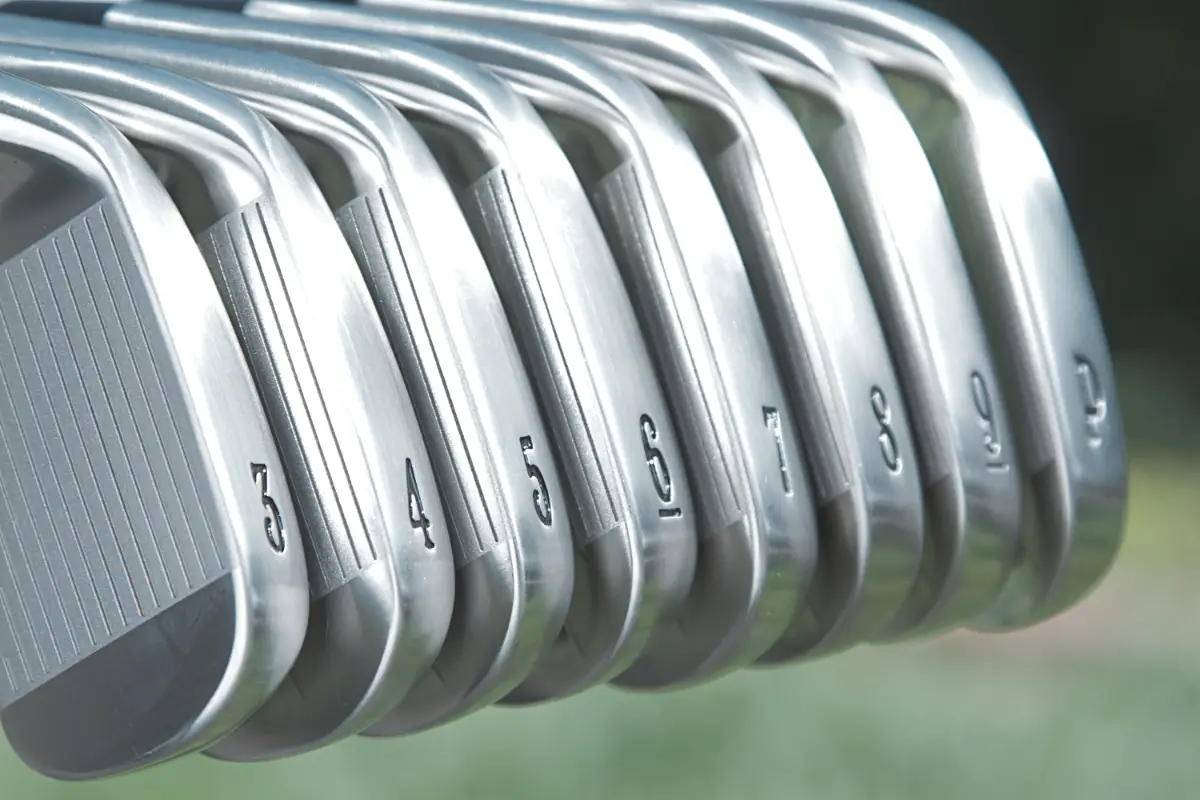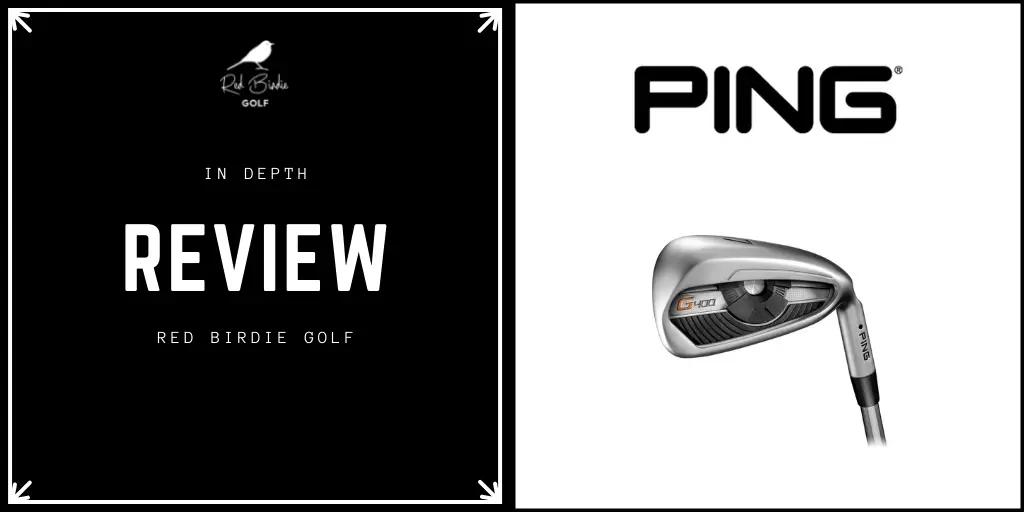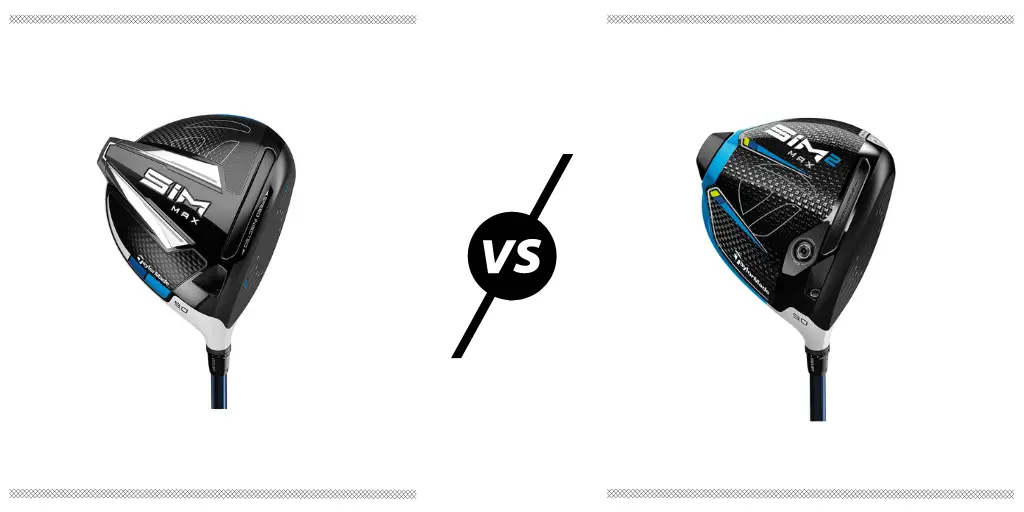***If you’re looking for the most recent reviews for 2023 gear, we will be updating this page in the summer after we’ve had a chance to review them!
If you’re in a hurry and just want to find the Best Blade Putters in 2022, then here’s what we recommend:
- Best Overall – Callaway Odyssey Triple Track Double Wide
- Best for Beginners and High Handicappers – Ping Sigma 2 Anser
- Best for Mid and Low Handicappers – Titleist Scotty Cameron Select Squareback 2
- Most Affordable Option – Wilson Staff Infinite West Loop
You may have heard the phrase, “Driving is for show, putting is for dough.” While this is not 100% true, the sentiment is that you can lower your score a lot more with a good putter than you can with a good drive.
In this article we’re going to look at how to select the best blade putter for your game.
We’re going to be reviewing the following blade putters:
- Evnroll ER2
- Titleist Scotty Cameron Select Squareback 2
- Wilson Staff Infinite West Loop
- Callaway Odyssey Triple Track Double Wide
- Mizuno M Craft Type 2
- TaylorMade Truss TB1
- Bettinardi BB8W
- Ping Sigma 2 Anser
- Cleveland Frontline 4.0
I remember playing a course in Stone Mountain, GA that had a 390 yard par-4 that dog legged to the right. At the time (and probably to this day) my natural drive has at least a fade to it if not a slice, so the hole set up perfectly for me. I took out my new TaylorMade driver, took a swing, and the ball stopped about 8 feet away from the hole. I lined up for my first ever eagle, aimed right at the hole, and 4 putts later I had myself a bogey.
Driving is, of course, an important aspect of the game, but if you want to lower your scores, you have to work on your putting. While there are 2 main styles of putters, the blade and the mallet, the overwhelming majority of players use a blade putter. These are the more compact and lighter weight putters that many golfers have grown accustomed to but mallets are definitely gaining momentum, especially on the PGA Tour. While we would generally suggest using a blade putter for mid and low handicappers, there are many different features, types, and brands and this article will help you figure out which one is best for you.
Why Choose a Blade Putter?
Blade putters are still the most popular putter style in the world today. There are a lot of reasons to choose a blade putter, but the first reason is the design. It is compact, simple, and looks great at setup. The second reason to choose a blade is that most golfers use an arced putting motion rather than a straight back and forth motion. The weighting system and size of a blade putter is better suited for this type of swing.
There is a reason that people like Sony televisions, Ford F-150s, and Ruth’s Chris Steakhouse. Some things just work. Blade putters have been the standard for years, and there is a reason for that. They work. When you look down at your putter, it is important that you feel confident in how it will perform. Most people prefer to see the blade putter over the mallet and putting is just as much in your head as it is in your technique.
Who Should Use a Blade Putter?
There is a specific type of golfer that will benefit from a blade putter. The following list highlights some of the checkpoints you should use when deciding whether or not a blade putter is for you:
- Does your putting stroke have an arc to it? If it does (and it probably does) then a blade is set up better for an arc while a mallet is set up more for a straight stroke.
- If you putt based more on feel and distance control, then a blade putter will be more your style. For those who have honed their feel and distance on the green, a mallet putter may suit you better, for everyone else, a blade is the way to go.
- If you are more of a traditionalist and are used to the style and look of a blade putter, it would probably be difficult to change.
- If you have good control over the face of your putter through impact, you should stick with a blade. Mallet putters will ensure a solid hit with added MOI, but for the majority of golfers, that is not their biggest putting weakness.
Should I Play a Blade or Mallet?
The main difference between a blade putter and a mallet putter is found in the distribution of weight. The majority of golfers favor a blade putter because of the feel, distance control, and traditional look of the club. While mallets have increased in popularity, there is still a large majority of golfers who have never used anything other than a blade and will probably never change.
Mallet putters put most of their weight away from the face of the club. This increases the MOI (moment of inertia) and decreases the chance of mishits because it decreases the chance for the face of the club to move to one side or the other.
Blade putters are more heavily weighted in the toe of the putter which makes for better feel and distance control on putts. This is especially important for beginning golfers and high handicap players because those players need the most help on distance control and feel.
Blade putters are still the most popular by a pretty large margin, but that margin seems to be decreasing by the year. In fact, mallet putters are becoming more and more popular with elite golfers and lower handicap players. Players who have already worked on their distance control and know the feel of the greens are helped most by the increased MOI. If you are just beginning your golf journey, struggle with your putting stroke, or just like the look and feel of a blade, you are still in the vast majority of golfers.
How to Choose the Best Blade Putter
Once you have decided that a blade putter is the way to go, it is time to decide which blade suits your game the best. Some of the decisions that you have to make include the length of the putter, what type of grip you will use, if you want a metal face or insert, and whether or not you want an offset head. Many of these different features can be found across brands and it is really up to you how much you want to spend on a putter. The key is to stick with the known and trusted brands and find the features that you want within that brand. The following reviews will help you decide which blade putter is for you.
Best Blade Putters Reviewed
Evnroll ER2
The Evnroll ER2 combines the advantages of a blade putter with the advantages of a mallet. The grooved face technology both increases the MOI of the club and the softness and feel at impact.
This putter looks great at setup and is easy to align with the hole.
Pros
- The face technology of this club is top-notch. The grooves start wide and grow narrower as they move from the center. This allows for both a bigger sweet spot and softer feel.
- One of the most consistent putters in terms of speed, distance, and roll.
- The steel head feels and sounds great at impact.
- It looks great at setup.
- A durable and thick grip.
Cons
- One of the more expensive putters on the list.
- The head is heavier than most blade putters.
Titleist Scotty Cameron Select Squareback 2
The Scotty Cameron Select Squareback 2 is a blade putter that has the size, weight, and forgiveness of a mallet. It looks great at setup, but it sacrifices feel for consistency, something that most elite golfers are glad to do.
The milled face both looks and performs well and allows for a consistent strike every time.
Pros
- It looks and feels like the most technologically advanced putter out there.
- Scotty Cameron has made and continues to make some of the best and most consistent putters on tour.
- The milled face looks great and helps to ensure great feel and consistency.
- The thin, flat topline of the putter makes it very easy to align and boosts your confidence over the shot.
- Custom lengths available.
- Weight is designed into the heel, toe, and perimeter to offer a large sweet spot.
Cons
- A very expensive putter.
- Sits too flat against the ground at setup.
- A little “clunky” feeling because of the size and weight of the clubhead.
Wilson Staff Infinite West Loop
Wilson has been one of the biggest names in golf since 1932 and they are not slowing down. The Wilson Staff line of golf balls and clubs is high quality at a better price than you can find with most brands and the Infinite West Loop is no exception.
Pros
- A great putter for a great price.
- The dark matte finish decreases glare, accentuates sight lines, and is visually appealing.
- The face is double milled for greater consistency.
- A very simple putter with good weight and balance. The counterbalance technology moves the balance point closer to the hands for better control.
- Great distance control.
- A new grip that enhances feel, is very durable, and helps to maintain club direction.
Cons
- Not as technologically advanced as some of the other putters.
- The sweet spot is smaller and produces more mishits if you do not hit the ball in the center of the face.
Callaway Odyssey Triple Track Double Wide
The Odyssey Triple Track Double Wide is a blade putter that has many of the strengths of a mallet. When paired with the triple track golf ball, your alignment can be on target with every putt and the increased MOI (similar to that of a mallet) will make sure the ball goes in the direction you are pointing.
The White Hot face insert has been a staple in the Callaway arsenal for years and it just keeps getting better.
Pros
- A mid-range price for a high end putter.
- Three horizontal stripes on a white background on the top of the club make it one of the easiest putters to align.
- The putter gives you the confidence of knowing that you are aimed correctly and that even a mishit will travel in the right direction.
- The White Hot face insert is firm yet forgiving while producing the sound that the Callaway putters have become known for.
- The counterweighting in the club promotes balance and consistent sweet spot contact.
- A huge sweet spot.
Cons
- Performs more like a mallet in some regards.
- If you swing with an arc, the alignment may seem off unless you set up with your club directly behind the ball.
- You need the Callaway triple track golf ball for this putter to reach its full potential.
Mizuno M Craft Type 2
The M Craft Type 2 is Mizuno’s first new putter roll out in close to 7 years and it does not disappoint. These putters look great at setup and they are very easy to align. The extra deep milling aids in alignment but even more so in feel and control. This is a classic blade design that is weighted well, feels great, and looks good at setup.
Pros
- The color options are unique and visually stunning. At the very least, they will make you look like you know how to putt.
- Adjustable weights allow you to change your putter based on conditions or a change in putting stroke.
- Deep milling on the face leads to extra feel and control.
- The carbon steel feels and sounds great at impact.
- The plumber’s neck allows the club to sit flat and aids in alignment while promoting an arced stroke.
Cons
- It is on the high end of cost.
- Mizuno has not been known for their putters, so it may take a while to build trust.
- Some players desire an insert for the added feel and softness and the face of this club is metal.
TaylorMade Truss TB1
The TaylorMade Truss TB1 is a truly new design for a putter. It looks like a blade at setup but the hosel design is thick and the MOI is high like what you find in a mallet.
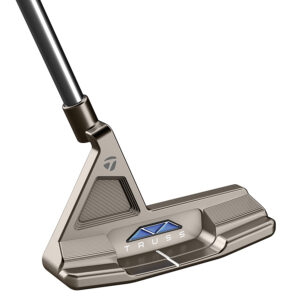
The bottom line is that this offering from TaylorMade is made with the stability and forgiveness of a mallet paired with the look of a blade. The result is something that looks different than what we have seen before but performs as well as any putter TaylorMade has developed.
Pros
- The stability of a mallet with the look of a blade.
- If there are 2 main types of putters, mallets and blades, this TaylorMade could almost be considered a hybrid taking on the benefits of each.
- They were designed to look like a traditional blade when standing over the club.
- The cobalt blue “True Roll” insert promotes great sound and feel and the grooves increase topspin to help the ball start and stay on the intended line.
- Adjustable sole weights allow you to cater the club to your needs.
Cons
- It is one of the more expensive options.
- It is a completely different look than what most players are accustomed to. This may appeal to some and turn others off.
Bettinardi BB8W
One of the first things you will notice is the option to specify the grip, length, lie, and loft of the putter to suit your exact specifications and game. The next thing you will notice is the simple but elegant look of the putter and this is all before you even pick it up.
It is weighted well, has a deep milled face, and is extra wide to assist in alignment. When you make contact with a ball, it sounds solid and produces a very consistent roll.
Pros
- The classic blade putter, just a little wider.
- Aligns very easily and is visually pleasing at setup.
- The milled face sounds and performs well.
- The Lamkin deep etched grips have some of the best feel of any putter on the list.
- The new “stealth black” finish reduces glare and contrasts well with the ball and the green.
- A simple look and feel with the technology and backing of a great company.
Cons
- One of the higher priced options.
- Not as consistent of a roll as some of the other putters at this price point.
- Not as much forgiveness on off center strikes.
Ping Sigma 2 Anser
The Ping Sigma 2 Anser has taken the layered technology used in ball manufacturing and applied it to a putter. The soft outer layer of the face is ideal for short putts while the firmer back layer takes over for longer putts making it the best of both worlds.
The firmer backing takes over on harder swings and the softer front is what gives you touch. On top of that, Ping offers an adjustable length shaft after finding out that approximately 8 out of 10 players play with the wrong length shaft.
Pros
- One of the lower priced putters on the list.
- A “dual durometer insert” provides a softer front layer for shorter putts and a firmer back layer for distance putts and off of the green.
- The face insert provides great feel and distance control.
- A higher MOI than many blades helps to produce a straighter and more consistent roll.
- “True Roll” technology features grooves machined directly into the insert for increased accuracy and feedback.
- An adjustable-length shaft provides players the opportunity to test out different lengths and settle on the one that suits them best.
- Fits an arc putting stroke.
Cons
- Not as appealing at setup as some of the other clubs making it a little more difficult to align.
Cleveland Frontline 4.0
Cleveland has always been known for their wedges, but they are an underrated putter maker as well. The Frontline 4.0 does some great things like moving the weight to the front of the face and producing an insert that helps to control the speed no matter where on the face the ball is struck.
Moving the weight to the front of a blade putter is actually quite revolutionary and many people will probably like the increased stability it provides.
Pros
- One of the least expensive options on the list.
- Tungsten forward weighting moves the center of gravity closer to the face of the club which increases stability through impact for more consistent putting.
- The speed optimized face technology normalizes the speed produced across the face for greater control and consistency.
- Made for players with a slight arc.
- Looks great at setup.
- No sharp lines to distract the eye, but great alignment tools to help get the ball started on the right path.
Cons
- Will not feel like your average blade putter which may be difficult for traditionalists to get used to.
- If you have a pronounced arc to your putting motion, this club will not work as well for you.
- Still too new to gauge its effectiveness.
Our Choice For The Best Blade Putters
Best Overall
Our choice for best overall putter is the Callaway Odyssey Triple Track Double Wide. Especially if you pair this putter with the Triple Track golf ball, one whole aspect of putting, alignment, is all but taken care of. On top of that, the White Hot insert promotes forgiveness and feel and the putter looks great at setup. With all of these advantages, the Odyssey Triple Track is also one of the best for distance control.
Best for Beginners and High Handicappers
The combination of the low price and great features make the Ping Sigma 2 Anser the right choice for beginners and high handicappers. The ability to adjust the shaft length sets this club apart and the dual durometer face increases touch on all shots.
Best for Mid and Low Handicappers
You cannot go wrong with the Titleist Scotty Cameron Select Squareback 2. One of the most important things when standing over a putt is confidence, and the technology behind this club coupled with its look gives you the confidence to strike the ball well with every putt.
Most Affordable Option
Not surprisingly, the most affordable option is the Wilson Staff Infinite West Loop. While it does not have all of the bells and whistles, it is a great putter at a great price.

